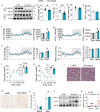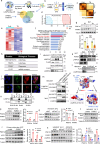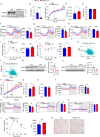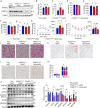Chaperone-mediated autophagy manipulates PGC1α stability and governs energy metabolism under thermal stress
- PMID: 40360527
- PMCID: PMC12075589
- DOI: 10.1038/s41467-025-59618-0
Chaperone-mediated autophagy manipulates PGC1α stability and governs energy metabolism under thermal stress
Abstract
Thermogenic proteins are down-regulated under thermal stress, including PGC1α· However, the molecular mechanisms are not fully understood. Here, we addressed that chaperone-mediated autophagy could regulate the stability of PGC1α under thermal stress. In mice, knockdown of Lamp2a, one of the two components of CMA, in BAT showed increased PGC1α protein and improved metabolic phenotypes. Combining the proteomics of brown adipose tissue (BAT), structure prediction, co-immunoprecipitation- mass spectrum and biochemical assays, we found that PARK7, a Parkinson's disease causative protein, could sense the temperature changes and interact with LAMP2A and HSC70, respectively, subsequently manipulate the activity of CMA. Knockout of Park7 specific in BAT promoted BAT whitening, leading to impaired insulin sensitivity and energy expenditure at thermoneutrality. Moreover, inhibiting the activity of CMA by knockdown of LAMP2A reversed the effects induced by Park7 ablation. These findings suggest CMA is required for BAT to sustain thermoneutrality-induced whitening through degradation of PGC1α.
© 2025. The Author(s).
Conflict of interest statement
Competing interests: The authors declare no competing interest.
Figures







Similar articles
-
GPX4 degradation contributes to heat stress-induced liver injury via chaperone-mediated autophagy.Biochim Biophys Acta Mol Cell Res. 2025 Aug;1872(6):119988. doi: 10.1016/j.bbamcr.2025.119988. Epub 2025 May 12. Biochim Biophys Acta Mol Cell Res. 2025. PMID: 40368268
-
Discovery of a potent inhibitor of chaperone-mediated autophagy that targets the HSC70-LAMP2A interaction in non-small cell lung cancer cells.Br J Pharmacol. 2025 May;182(10):2287-2309. doi: 10.1111/bph.16165. Epub 2023 Jul 12. Br J Pharmacol. 2025. PMID: 37311689
-
Age-dependent accumulation of oligomeric SNCA/α-synuclein from impaired degradation in mutant LRRK2 knockin mouse model of Parkinson disease: role for therapeutic activation of chaperone-mediated autophagy (CMA).Autophagy. 2020 Feb;16(2):347-370. doi: 10.1080/15548627.2019.1603545. Epub 2019 Apr 14. Autophagy. 2020. PMID: 30983487 Free PMC article.
-
Chaperone-Mediated Autophagy and Its Emerging Role in Hematological Malignancies.Cells. 2019 Oct 16;8(10):1260. doi: 10.3390/cells8101260. Cells. 2019. PMID: 31623164 Free PMC article. Review.
-
Molecular control of chaperone-mediated autophagy.Essays Biochem. 2017 Dec 12;61(6):663-674. doi: 10.1042/EBC20170057. Print 2017 Dec 12. Essays Biochem. 2017. PMID: 29233876 Review.
References
-
- Cannon, B. & Nedergaard, J. Brown adipose tissue: function and physiological significance. Physiol. Rev.84, 277–359 (2004). - PubMed
-
- Cannon, B., de Jong, J. M. A., Fischer, A. W., Nedergaard, J. & Petrovic, N. Human brown adipose tissue: Classical brown rather than brite/beige? Exp. Physiol.105, 1191–1200 (2020). - PubMed
MeSH terms
Substances
LinkOut - more resources
Full Text Sources
Miscellaneous

